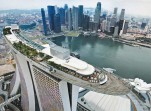Full-Service Urban Land Improvement of Business Centers

“Everything is subject to power lines. They penetrate you and set you alive; they attract or repel you; they merge with you or resist you. And you feel strongly, reliably and sustainably rooted in the center of the main living areas. Everything is drawn to the poles. The most populous city becomes empty, if its basic living poles get neutralized. Order for the sake of order emasculates a person, depriving him or her of the main gift of transforming the world and him/herself. Life creates order, but order does not create life”. Antoine de Saint-Exupery “Letter to a Hostage”
Importance of the Fullservice Urban Land Improvement of Business Centers
Full-service urban land improvement (hereinafter – improvement) of the manmade and natural environment of the development is the result of the synthesis of architecture and fine arts, monumental and decorative, handicraft, park and garden as well as environmental design among them that consists of improvement elements of everyday and festive use. The improvement is manifested in a set of features; they are architectural and aesthetic, visual and communicative, recreational and life-supporting, service-utility, industrial design and engineering.
This is the way the design aspects of improvement are treated in theoretical works, in particular and others that are mentioned in the reference lists and notes, in the regional building regulations and standards, in the governing documents and recommendations, in the academic literature.
Improvement elements are products made of artistic and artisanal details of industrial or handicraft origin and/ or of building (range) origin, including: massive that are used for sets of buildings and structures, those of small circulation that are used for stand-alone structures; and single (unique) ones that are used to certain sites. It also refers to non-permanent structures with a lifetime of no more than 10 years as well as non-stationary mobile buildings or ready-made tents, belvederes, stages, podiums, stands, trays, etc.
Full content of this issue you can read here
The full version of the article can be read in our printed issue, also you can subscribe to the web-version of the magazine
 Text: Alexey Kryukov, PH.D. in Architecture; TSNIIEP ZHILISHCHA, JSC;
Text: Alexey Kryukov, PH.D. in Architecture; TSNIIEP ZHILISHCHA, JSC;
Illustrations by Alexey Kryukov, Georgy Kryukov


